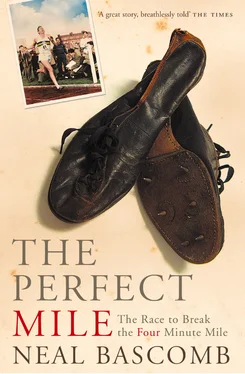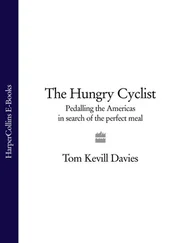J. Allen Murray was there to help him on this path. Murray was Ashland’s high-school track and field coach (as well as history teacher and basketball/football coach). He believed Santee could be the next Glenn Cunningham, the most famous United States middle-distance runner and a Kansas native. The problem was that Santee barely had enough time for classes, let alone running, because his father wanted him home to work. Murray told Wes that if he didn’t have time to train, he should just continue to run everywhere he went. That was fine with Santee.
Finally the time came for his first track meet. Scheduled for a Saturday, the meet was delayed until Monday because of a thunderstorm. Unfortunately, Santee worked on Mondays, and he knew his father would object to losing an afternoon of his free labour. Murray told him he would take care of it. The next evening he walked up the steps to the Santees’ house. He had invited himself to dinner. Wes’s father normally greeted visitors with a .22-calibre pistol and an offer of five minutes to get off his property. This time David Santee at least pushed open the door, but his hospitality ended there. Through dinner and dessert, Coach Murray explained to Wes’s parents why they should allow their son to attend the meet – how it was good for the boy to be challenged in competition. David Santee didn’t utter a word the entire evening: not a yes, not a no. Murray left without an answer, and Wes disappeared into the fields afterwards. Alone in the dark, he clawed at the dirt and grass, wondering how he would ever get out of this place. If he hadn’t learned to hate his father before this night, he did so now.
The next day Coach Murray told him to get up early on Monday to do his chores; he would pick him up at seven o’clock. Santee rose at four, hauled feed, milked the cows, and did everything required of him before his coach arrived. David Santee was working in the fields and thought his son had simply left for school. It was the first time Wes had left the county, and although he was the youngest in the mile race, unaware of competition tactics and scared after having disobeyed his father, he placed third. He was awarded a red ribbon and could barely stand still with the excitement. But then he had to go home. When he entered the house, his father was sitting at the table. From the grim look on his face he obviously knew that Wes had gone to the meet.
‘I won third place,’ Wes said with sheepish excitement.
‘If you have time to miss school and do all this’ – his father bit off each word – ‘then you have time to get all the rest of the ploughing done.’
For some eighteen hours, Wes Santee sat on the tractor, ploughing miles of fields without a break for lunch, and certainly not for school. His throat burned from thirst, his spine ached from the jarring movements of the tractor on uneven terrain, and his hands were rubbed raw from gripping the wheel. Working from dawn until ten o’clock at night, Wes finished two days of ploughing in one. As a man who spent most of his youth labouring on the farm, he would remember that day as the hardest he had ever endured. When he finally returned to school, Murray asked if he was all right. Santee nodded. Murray then asked him if he wanted to go to the next meet in Mead, Kansas. Santee said yes.
After Wes left, Murray called the ranch to say one thing to Santee’s father: ‘I want you to bring your truck in and haul some kids to Mead.’ David Santee didn’t reply, but the tone in Coach Murray’s voice made him understand that he didn’t have a choice in the matter. Like most bullies, David Santee folded when someone finally stood up to him. The next week he showed up on time with his truck, and though it angered him that his son was wasting time that would be better spent on the ranch, he never got in the way of Wes’s running again.
Over the next four years, Wes Santee scorched around tracks throughout Kansas. He won two state mile championships, broke Glenn Cunningham’s state high-school record, became the favourite son of Ashland, and was targeted by college track recruiters from coast to coast. He had found his way out, and now there was nothing that could stand in his way. He trained as much as possible, studied hard to keep his grades up, and decided not to let things get too far with his high-school girlfriend because recruiters were not interested in athletes with wives or children. Shutting himself down with her was not easy, but he had to get out of Ashland.
When Bill Easton, the University of Kansas track and field coach, offered him a scholarship in 1949, Santee accepted. Over the previous two years Easton had won his confidence, probably because he was everything Santee’s father was not: he wore a coat and tie, spoke intelligently, won friends easily, and backed up his words with action. Under Easton’s guidance and encouragement, the KU track team had become one of the country’s best.
The summer before he left for college, Wes had his last confrontation with his father. While he dug yet another six-foot-deep hole in the hard ground for the soon-to-arrive electricity poles, his father started pounding on his back with his fists because he was digging too slowly. That was it. The 17-year-old, his shirt soaked with sweat and hands blistered from the work, stormed back to the house, informed his mother he was leaving, and said goodbye to Henry and Ina May. In the stable, he saddled Bess, the horse his father had given him, and put a halter on a second mare, which Wes had yet to name (a local farmer had given her to Wes in exchange for breaking some horses). He then led his two horses towards the front gate, a cloud of dust from their hooves trailing behind them.
Suddenly, his father appeared from behind the barn and blocked his way. ‘You’re not taking that horse anywhere,’ he said, gesturing towards Bess.
Sensing the coiled violence in the rigid way his father stood in front of him, Wes grimly said ‘Okay’ and unstrapped his saddle from Bess. He then threw it over the other horse, which had never been ridden before, and led her through the gate, leaving his father without a goodbye. When he was two hundred yards away, Santee carefully hoisted himself up on the horse and rode into town. He stayed with a friend who owned the local ice plant and had once told him that he could stay with him if things ever got too bad at the ranch. Santee lived there until college began.
In Lawrence, Santee fell under the protection of Bill Easton. The coach invited the youth, who had almost nothing with him but the clothes on his back, to stay at his house until his dormitory was ready. Santee might have been bold-talking and powerful, but he needed someone to care for him. The first morning, over a breakfast of bacon and eggs, Easton told Santee that he needed to set a good example and help lead the team. Easton spoke to him like an equal, and Santee listened.
Coach Murray had given him the opportunity to run; Coach Easton showed Santee how to turn his raw talent as a runner into greatness. It had little to do with changing his short, clipped stride, which had become ingrained in his youth while running along plough furrows and through pastures where a long stride would have been dangerous on the uneven terrain. Santee did not bring his arms back in a normal long arc, nor drive to the extreme with his kicking foot like most distance runners. Instead he had the quick arm swing and knee action of a sprinter. But with his native speed, coordination, long legs, strong shoulders, and ability to relax, he was able to sustain this sprinter style over long distances. Easton was convinced that reshaping his stride into a more classical motion would do more harm than good, so he taught Santee to harness his power through training, pace judgement, and focus. Soon enough, seniors on his team were struggling to keep up with him in practice and competition.
Читать дальше












